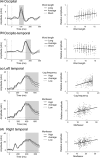Information properties of morphologically complex words modulate brain activity during word reading
- PMID: 29524274
- PMCID: PMC5969226
- DOI: 10.1002/hbm.24025
Information properties of morphologically complex words modulate brain activity during word reading
Abstract
Neuroimaging studies of the reading process point to functionally distinct stages in word recognition. Yet, current understanding of the operations linked to those various stages is mainly descriptive in nature. Approaches developed in the field of computational linguistics may offer a more quantitative approach for understanding brain dynamics. Our aim was to evaluate whether a statistical model of morphology, with well-defined computational principles, can capture the neural dynamics of reading, using the concept of surprisal from information theory as the common measure. The Morfessor model, created for unsupervised discovery of morphemes, is based on the minimum description length principle and attempts to find optimal units of representation for complex words. In a word recognition task, we correlated brain responses to word surprisal values derived from Morfessor and from other psycholinguistic variables that have been linked with various levels of linguistic abstraction. The magnetoencephalography data analysis focused on spatially, temporally and functionally distinct components of cortical activation observed in reading tasks. The early occipital and occipito-temporal responses were correlated with parameters relating to visual complexity and orthographic properties, whereas the later bilateral superior temporal activation was correlated with whole-word based and morphological models. The results show that the word processing costs estimated by the statistical Morfessor model are relevant for brain dynamics of reading during late processing stages.
Keywords: MEG; Morfessor; N400m; computational linguistics; computational modeling; language; morphology; orthography; surprisal.
© 2018 The Authors Human Brain Mapping Published by Wiley Periodicals, Inc.
Figures



Similar articles
-
Reading in a deep orthography: neuromagnetic evidence for dual-mechanisms.Exp Brain Res. 2007 Jun;180(2):247-62. doi: 10.1007/s00221-007-0852-0. Epub 2007 Jan 26. Exp Brain Res. 2007. PMID: 17256164 Free PMC article.
-
Using Statistical Models of Morphology in the Search for Optimal Units of Representation in the Human Mental Lexicon.Cogn Sci. 2018 Apr;42(3):939-973. doi: 10.1111/cogs.12576. Epub 2017 Dec 19. Cogn Sci. 2018. PMID: 29265549
-
Misspelled-Word Reading Modulates Late Cortical Dynamics.Hum Brain Mapp. 2025 Jun 1;46(8):e70247. doi: 10.1002/hbm.70247. Hum Brain Mapp. 2025. PMID: 40503587 Free PMC article.
-
Words in the brain's language.Behav Brain Sci. 1999 Apr;22(2):253-79; discussion 280-336. Behav Brain Sci. 1999. PMID: 11301524 Review.
-
The what, when, where, and how of visual word recognition.Trends Cogn Sci. 2014 Feb;18(2):90-8. doi: 10.1016/j.tics.2013.11.005. Epub 2013 Dec 25. Trends Cogn Sci. 2014. PMID: 24373885 Review.
Cited by
-
Subword Representations Successfully Decode Brain Responses to Morphologically Complex Written Words.Neurobiol Lang (Camb). 2024 Sep 11;5(4):844-863. doi: 10.1162/nol_a_00149. eCollection 2024. Neurobiol Lang (Camb). 2024. PMID: 39301210 Free PMC article.
-
Early Form-Based Morphological Decomposition in Tagalog: MEG Evidence from Reduplication, Infixation, and Circumfixation.Neurobiol Lang (Camb). 2022 Feb 16;3(2):235-255. doi: 10.1162/nol_a_00062. eCollection 2022. Neurobiol Lang (Camb). 2022. PMID: 37215559 Free PMC article.
References
-
- Assadollahi, R. , & Pulvermüller, F. (2003). Early influences of word length and frequency: A group study using MEG. Neuroreport, 14(8), 1183–1187. - PubMed
-
- Barlow, H. B. (1961). Possible principles underlying the transformations of sensory messages In: Rosenblith W.A. (Ed.) Sensory Communication, Cambridge, MA: MIT Press, pp. 217–234.
-
- Berger, A. L. , Pietra, V. J. D. , & Pietra, S. A. D. (1996). A maximum entropy approach to natural language processing. Computational Linguistics, 22, 39–71.
-
- Butterworth, B. (1983). Lexical representation In: Butterworth B. (Ed.), Language Production, vol. 2 London: Academic Press, pp. 257–294.
-
- Carreiras, M. , Perea, M. , & Grainger, J. (1997). Effects of orthographic neighborhood in visual word recognition: Cross‐task comparisons. Journal of Experimental Psychology. Learning, Memory, and Cognition, 23(4), 857–871. - PubMed
Publication types
MeSH terms
LinkOut - more resources
Full Text Sources
Other Literature Sources

